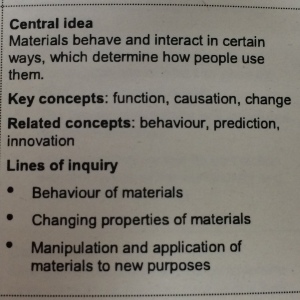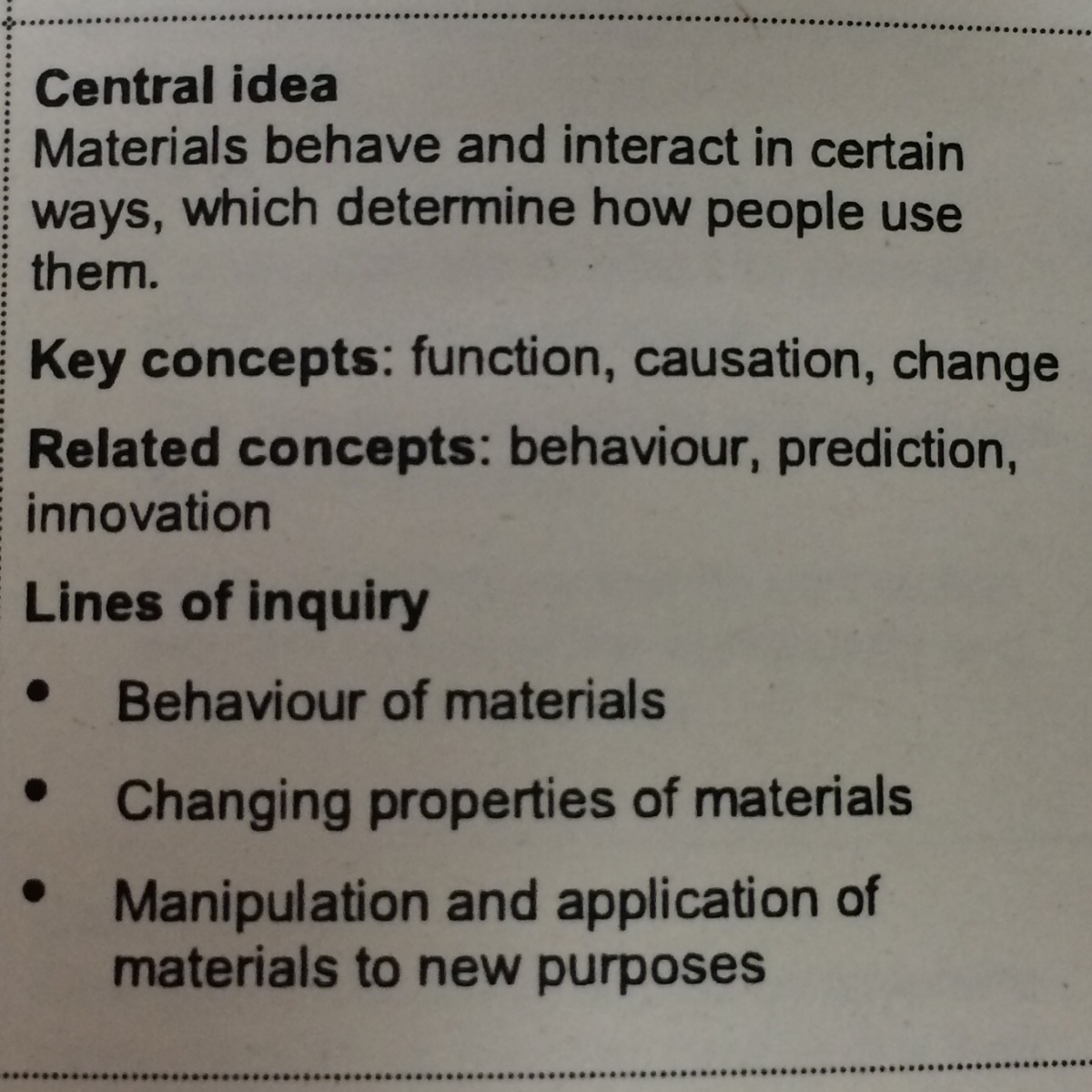This week, I am analyzing a program of inquiry from the PYP Sample Planner. I have chosen the Unit of Inquiry for students ages 4-5 that addresses the transdisciplinary theme “How the world works”.

This Unit of Inquiry is designed to address the transdisciplinary theme: How the world works. It is aimed at PYP Learners ages 4-5.
How well does the central idea reflect the concepts identified?
From the central idea, my impression of this unit of inquiry is that students will be investigating the different forms that materials take, observe possible functions and determine ways to use the materials. There would also be a part of the lesson involving using materials with different functions together to create a new function.
The key concepts for this unit (Function, Causation, and Change) focus on the “How?” of materials. This implies that the lessons will focus primarily on examining the mechanism of change that affects materials and the usage of that material in its new form. Considering that, two key concepts, Function and Change, are directly addressed by the central idea; however, Causation (Why is it like that?) seems like a concept that would be naturally addressed during the process of inquiry but doesn’t directly address any of the goals mentioned in the central idea.
I would probably add Form to the key concepts because the students’ will be heavily relying observation during this unit. I feel like there should at least be some pre-lesson scaffolding using the students’ schema to cover Form. The lessons in the Kindergarten class at DESK come to mind as a good way to review and build on students’ schema.
The related concepts (behavior, prediction, and innovation) fit perfectly with the intent of the central idea and lay out a loose framework for how the inquiry process should be shaped.
How well does the central idea reflect an aspect of the transdisciplinary theme identified?
From Making the PYP Happen, “How the world works”:
An inquiry into the natural world and its laws; the interaction between the natural world (physical and biological) and human societies; how humans use their understanding of scientific principles; the impact of scientific and technological advances on society and on the environment.
I think that the central idea does a beautiful job of addressing the transdisciplinary theme, “How the world works”, in a way that provides a myriad of possibilities for scientific inquiry and exploration. Students will be able to directly experience the interaction of materials from the natural environment and the people that use them. It will also help students experience the importance of observation and exploration in the discovery of useful functions of materials.
How well does the unit provide opportunity to explore multiple subject-related concepts and knowledge through multiple perspectives?
This unit can be widely applied to different subjects, and students can use their own perspectives and experiences to contribute to the classroom dialogue about different materials and material functions.
Science: The unit has scientific inquiry built into the theme it is addressing, so science is a huge part of the learning experience.
English/Language Arts: PYP instructors can include literature focused on characters discovering new objects and materials and finding use for them. Students can exchange or write stories about a material and what they use it for.
Math: Students can use tangibles in their classrooms as a visual assist to their current math lesson. The PYP instructors can then lead a class reflection on why that material helped with the lesson.
History/Social Studies/Multicultural Exchange: Students can learn about what different materials various cultures use for the same function. Students can share materials that they use at home for a given function.
Which subjects do you think are most relevant to exploring the central idea?
I think that Science and History/Social Studies/Multicultural Exchange are the most relevant subjects because they connect scientific discovery to the human application of materials. The skills that the students will gain through the exploration of materials and their functions combined with learning about how different people can use different materials to perform the same function will directly fulfill the central idea while also helping teach to the PYP Learner Profile.
Devise some open-ended Teacher Questions that would help learners to explore the lines of inquiry.
What is a material?
How can we describe a material (What words can we use to describe a material)?
How can we change how a [material] looks?
How can a material’s form change how we use it?

